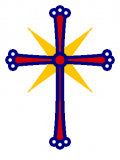Babai the Great
| Part of the series on Church of the East |

|
| Association |
| Communion of the Church of the East |
| Member Churches |
| Assyrian Church Borneian Church Religion of Light Chaldean Syrian Church Church of the East in Arakan, Burma and Tenasserim |
| Topics |
| Catholicos Assyrian Monasticism Assyrian Hospitals School of Samarqand Monastery of Mar Toma |
| People |
Babai the Great was Catholicos of the Holy Apostolic Catholic Assyrian Church of the East from 609-633. One of the most prominent theologians of the Church of the East, he systematised the Church's theology, developed the definitive Christology of the Church and wrote numerous treatises on scriptural interpretation and against various heretical tendencies within the Assyrian communion.
He was born in c.551 in Beth Zabdai, and studied at the School of Nisibis. Under the influence of Abraham of Qaşgar he became involved in the reformation of the Assyrian monastic movement, and in the last years of Catholicos Mar Sabiryeshu (Sabrisho) I, he was given the office of Visitor of the Monasteries of the North.
It was following the death of Mar Sabiryeshu I, though, that his career reached its peak. The then Persian Shah Khosru II has recently acquired the western Syrian provinces of his empire, which were heavily dominated by the Monophysite branch of Christianity, and in order to pacify the monophysites, he began to reverse the limited favour which had been bestowed on their great rivals the Nestorian Assyrians. Thus, the heretical Origenist Henana of Adiabene was promoted to the leadership of the School of Nisibis, and on the death of Mar Sabiryeshu I, one of Henana's disciples was suggested by Shah Khosru II as the new Catholicos.
The Metropolitan Synod rejected Khosru's candidate, choosing instead Mar Gregorius I. However, Mar Gregorius died only 5 years later, and the Shah's physician, until recently a member of the Assyrian community, now replaced by a Monophysite, suggested Henana himself as Catholicos.
Thing might have gone differently, but in the summer of 609, Shah Khosru's wife contracted an illness which the Monophysite court physician was unable to cure. After turning to his previous (Nestorian) court physician Mertas, who proved able to restore his wife's health, the Shah reversed some of his ire against the Assyrian Church. Thus, the Synod proceeded to elect Babai as Catholicos without any political interference from the court.
One of Babai's first acts was to remove Henana from his headmastership of the School of Nisibis. This was still a chancy prospect, given that there was still a powerful Monophysite-leaning faction in the court, as well as the disciples of Henana within the Church itself, but Babai was able to carry it through.
Even after his removal from office, Henana was a powerful adversary, and much of the early part of Babai's Patriarchate was devoted to curbing the influence of Henana's disciples and their teaching. He wrote at least 84 doctrinal works, most against the Monophysites, but also against Manes, Marcion and others considered by the Church of the East to be in error.
His Patriarchate was characterised by a return to the scholasticism of the early Assyrian Church, by the carrying-through of Abraham of Qaşgar's monastic reforms, and by the defining of a lot of the theology of the Church of the East. Babai's theological works are still considered normative for the Assyrian Church, and his Teshbokhta, or "Hymn of Praise", is one of the earliest concise systematic explanations of Assyrian Christology. Much of this was as a direct result of his theological quarrels with Henana of Adiabene and his supporters, and to his death he was reported to be always ready to defend or expound the historic truths of Assyrian theology.
The Communion of the Church of the East still knows him as "the Great". His remembrance in the Assyrian Church is on 17th June.
|
Preceded by: |
|
Succeeded by: |
